http://blog.csdn.net/wufenglong/article/details/5778862
PC 客户端与 Android 服务端的 Socket 同步通信(USB)
分类: android 2010-07-31 17:23 8027 人阅读 评论(52) 收藏 举报
需求:
1.一个 android 端的 service 后台运行的程序,作为 socket 的服务器端;用于接收 Pc client 端发来的命令,来处理
数据后,把结果发给 PC client
2.PC 端程序,作为 socket 的客户端,用于给 android 手机端发操作命令
难点分析:
1.手机一定要有 adb 模式,即插上 USB 线时马上提示的对话框选 adb。好多对手机的操作都可以用 adb 直接作。
不过,我发现 LG GW880 就没有,要去下载个
2.android 默认手机端的 IP 为“127.0.0.1”
3.要想联通 PC 与 android 手机的 sokcet,一定要用 adb forward 来作下端口转发才能连上 socket.
view plaincopy to clipboardprint?
1. Runtime.getRuntime().exec("adb forward tcp:12580 tcp:10086");
2.
Thread.sleep(3000);
Runtime.getRuntime().exec("adb forward tcp:12580 tc
Thread.sleep(3000);
4.android 端的 service 程序 Install 到手机上容易,但是还要有方法来从 PC 的 client 端来启动手机上的 service ,这个办法可以通过
PC 端 adb 命令来发一个 Broastcast ,手机端再写个接收 BroastcastReceive 来接收这个 Broastcast,在这个 BroastcastReceive 来启动
service
�
pc 端命令:
view plaincopy to clipboardprint?
1. Runtime.getRuntime().exec(
2. "adb shell am broadcast -a NotifyServiceStart");
Runtime.getRuntime().exec(
"adb shell am broadcast -a NotifyServiceStart");
android 端的代码:ServiceBroadcastReceiver.java
view plaincopy to clipboardprint?
1. package com.otheri.service;
2.
3. import android.content.BroadcastReceiver;
4. import android.content.Context;
5. import android.content.Intent;
6. import android.util.Log;
7.
8. public class ServiceBroadcastReceiver extends BroadcastReceiver {
9.
10.
11.
12.
13.
14.
private static String START_ACTION = "NotifyServiceStart";
private static String STOP_ACTION = "NotifyServiceStop";
@Override
public void onReceive(Context context, Intent intent) {
Log.d(androidService.TAG, Thread.currentThread().getName() + "---->"
�
+ "ServiceBroadcastReceiver onReceive");
String action = intent.getAction();
if (START_ACTION.equalsIgnoreCase(action)) {
context.startService(new Intent(context, androidService.class));
Log.d(androidService.TAG, Thread.currentThread().getName() + "---->"
+ "ServiceBroadcastReceiver onReceive start end");
} else if (STOP_ACTION.equalsIgnoreCase(action)) {
context.stopService(new Intent(context, androidService.class));
Log.d(androidService.TAG, Thread.currentThread().getName() + "---->"
+ "ServiceBroadcastReceiver onReceive stop end");
}
}
15.
16.
17.
18.
19.
20.
21.
22.
23.
24.
25.
26.
27.
28.
29.
30. }
package com.otheri.service;
import android.content.BroadcastReceiver;
import android.content.Context;
import android.content.Intent;
import android.util.Log;
public class ServiceBroadcastReceiver extends Broad
private static String START_ACTION = "Notif
private static String STOP_ACTION = "Notify
@Override
public void onReceive(Context context, Inte
Log.d(androidService.TAG, Thread.cu
+ "ServiceBroadcast
String action = intent.getAction();
if (START_ACTION.equalsIgnoreCase(a
5.由于是 USB 连接,所以 socket 就可以设计为一但连接就一直联通,即在 new socket 和开完 out,in 流后,就用个
while(true){}来循环 PC 端和 android 端的读和写
android 的代码:
view plaincopy to clipboardprint?
1. public void run() {
2.
3.
4.
5.
6.
Log.d(androidService.TAG, Thread.currentThread().getName() + "---->"
+ "a client has connected to server!");
BufferedOutputStream out;
BufferedInputStream in;
try {
�
7.
8.
9.
10.
11.
12.
13.
14.
15.
16.
17.
18.
19.
20.
21.
22.
23.
24.
25.
26.
27.
28.
29.
30.
31.
32.
33.
34.
35.
36.
37.
38.
39.
40.
41.
42.
43.
44.
45.
46.
/* PC 端发来的数据 msg */
String currCMD = "";
out = new BufferedOutputStream(client.getOutputStream());
in = new BufferedInputStream(client.getInputStream());
// testSocket();// 测试 socket 方法
androidService.ioThreadFlag = true;
while (androidService.ioThreadFlag) {
try {
if (!client.isConnected()) {
break;
}
/* 接收 PC 发来的数据 */
Log.v(androidService.TAG, Thread.currentThread().getName()
+ "---->" + "will read......");
/* 读操作命令 */
currCMD = readCMDFromSocket(in);
Log.v(androidService.TAG, Thread.currentThread().getName()
+ "---->" + "**currCMD ==== " + currCMD);
/* 根据命令分别处理数据 */
if (currCMD.equals("1")) {
out.write("OK".getBytes());
out.flush();
} else if (currCMD.equals("2")) {
out.write("OK".getBytes());
out.flush();
} else if (currCMD.equals("3")) {
out.write("OK".getBytes());
out.flush();
} else if (currCMD.equals("4")) {
/* 准备接收文件数据 */
try {
out.write("service receive OK".getBytes());
out.flush();
} catch (IOException e) {
e.printStackTrace();
}
/* 接收文件数据,4 字节文件长度,4 字节文件格式,其后是文件数据 */
�
47.
48.
49.
50.
51.
52.
53.
54.
55.
56.
57.
58.
59.
60.
61.
62.
63.
64.
65.
66.
67.
68.
69.
70.
71.
72.
73.
74.
75.
76.
77.
78.
79.
80.
81.
82.
83.
84.
85.
86.
byte[] filelength = new byte[4];
byte[] fileformat = new byte[4];
byte[] filebytes = null;
/* 从 socket 流中读取完整文件数据 */
filebytes = receiveFileFromSocket(in, out, filelength,
fileformat);
// Log.v(Service139.TAG, "receive data =" + new
// String(filebytes));
try {
/* 生成文件 */
File file = FileHelper.newFile("R0013340.JPG");
FileHelper.writeFile(file, filebytes, 0,
filebytes.length);
} catch (IOException e) {
e.printStackTrace();
}
} else if (currCMD.equals("exit")) {
}
} catch (Exception e) {
// try {
// out.write("error".getBytes("utf-8"));
// out.flush();
// } catch (IOException e1) {
// e1.printStackTrace();
// }
Log.e(androidService.TAG, Thread.currentThread().getName()
+ "---->" + "read write error111111");
}
}
out.close();
in.close();
} catch (Exception e) {
Log.e(androidService.TAG, Thread.currentThread().getName()
+ "---->" + "read write error222222");
e.printStackTrace();
} finally {
try {
�
87.
88.
89.
90.
91.
92.
93.
94.
95.
96.
97.
if (client != null) {
Log.v(androidService.TAG, Thread.currentThread().getName()
+ "---->" + "client.close()");
client.close();
}
} catch (IOException e) {
Log.e(androidService.TAG, Thread.currentThread().getName()
+ "---->" + "read write error333333");
e.printStackTrace();
}
}
public void run() {
Log.d(androidService.TAG, Thread.cu
+ "a client has con
BufferedOutputStream out;
BufferedInputStream in;
try {
/* PC端发来的数据msg */
String currCMD = "";
out = new BufferedOutputStr
in = new BufferedInputStrea
// testSocket();// 测试sock
androidService.ioThreadFlag
while (androidService.ioThr
try {
if (!client
bre
}
6.如果是在 PC 端和 android 端的读写操作来 while(true){}循环,这样 socket 流的结尾不好判断,不能用“-1”来判断,
因为“-1”是只有在 socket 关闭时才作为判断结尾。
7.socket 在 out.write(bytes);时,要是数据太大时,超过 socket 的缓存,socket 自动分包发送,所以对方就一定要用
循环来多次读。最好的办法就是服务器和客户端协议好,比如发文件时,先写过来一个要发送的文件的大小,然后再
发送文件;对方用这个大小,来循环读取数据。
android 端接收数据的代码:
view plaincopy to clipboardprint?
1. /**
2.
3.
4.
5.
6.
7.
8.
9.
* 功能:从 socket 流中读取完整文件数据
*
* InputStream in:socket 输入流
*
* byte[] filelength: 流的前 4 个字节存储要转送的文件的字节数
*
* byte[] fileformat:流的前 5-8 字节存储要转送的文件的格式(如.apk)
*
�
10.
11.
12.
13.
14.
15.
16.
17.
18.
19.
20.
21.
22.
23.
24.
25.
26.
27.
28.
29.
30.
31.
32.
33.
34.
35.
36.
* */
public static byte[] receiveFileFromSocket(InputStream in,
OutputStream out, byte[] filelength, byte[] fileformat) {
byte[] filebytes = null;// 文件数据
try {
int filelen = MyUtil.bytesToInt(filelength);// 文件长度从 4 字节 byte[]转成 Int
String strtmp = "read file length ok:" + filelen;
out.write(strtmp.getBytes("utf-8"));
out.flush();
filebytes = new byte[filelen];
int pos = 0;
int rcvLen = 0;
while ((rcvLen = in.read(filebytes, pos, filelen - pos)) > 0) {
pos += rcvLen;
}
Log.v(androidService.TAG, Thread.currentThread().getName()
+ "---->" + "read file OK:file size=" + filebytes.length);
out.write("read file ok".getBytes("utf-8"));
out.flush();
} catch (Exception e) {
Log.v(androidService.TAG, Thread.currentThread().getName()
+ "---->" + "receiveFileFromSocket error");
e.printStackTrace();
}
return filebytes;
}
/**
* 功能:从socket流中读取完整文件数据
*
* InputStream in:socket输入流
*
* byte[] filelength: 流的前4个字节存储要转送
*
* byte[] fileformat:流的前5-8字节存储要转送
*
* */
public static byte[] receiveFileFromSocket(
OutputStream out, byte[] fi
byte[] filebytes = null;// 文件数据
try {
int filelen = MyUtil.bytesT
String strtmp = "read file
out.write(strtmp.getBytes("
out.flush();
8.socket 的最重要的机制就是读写采用的是阻塞的方式,如果客户端作为命令发起者,服务器端作为接收者的话,只
有当客户端 client 用 out.writer()写到输出流里后,即流中有数据 service 的 read 才会执行,不然就会一直停在 read()
那里等数据。
�
9.还要让服务器端可以同时连接多个 client,即服务器端用 new thread()来作数据读取操作。
源码:
客户端(pc 端):
testPcClient.java
view plaincopy to clipboardprint?
1. import java.io.BufferedInputStream;
2. import java.io.BufferedOutputStream;
3. import java.io.BufferedReader;
4. import java.io.ByteArrayOutputStream;
5. import java.io.IOException;
6. import java.io.InputStream;
7. import java.io.InputStreamReader;
8. import java.net.InetAddress;
9. import java.net.Socket;
10. import java.net.UnknownHostException;
11.
12. public class testPcClient {
13.
14.
15.
16.
17.
18.
19.
20.
21.
/**
* @param args
* @throws InterruptedException
*/
public static void main(String[] args) throws InterruptedException {
try {
Runtime.getRuntime().exec(
"adb shell am broadcast -a NotifyServiceStop");
�
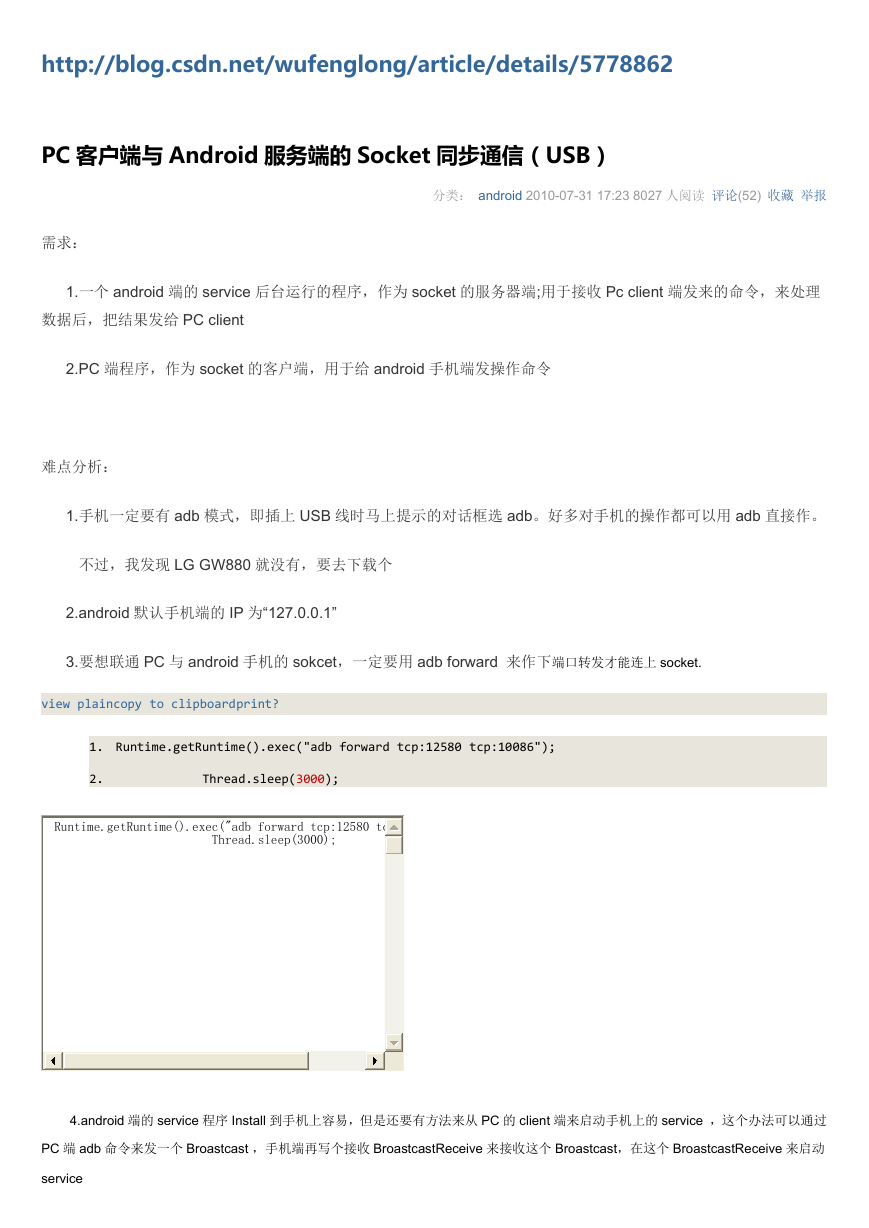
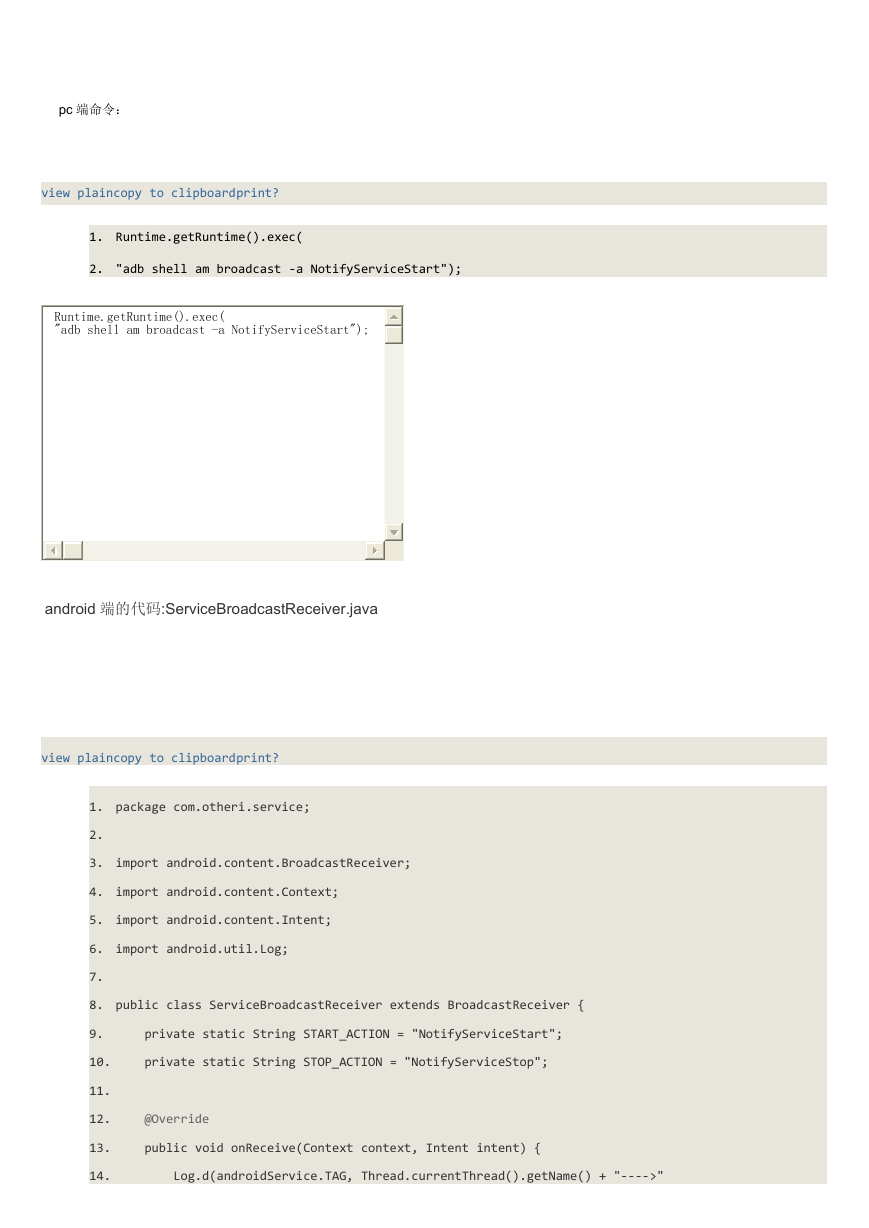

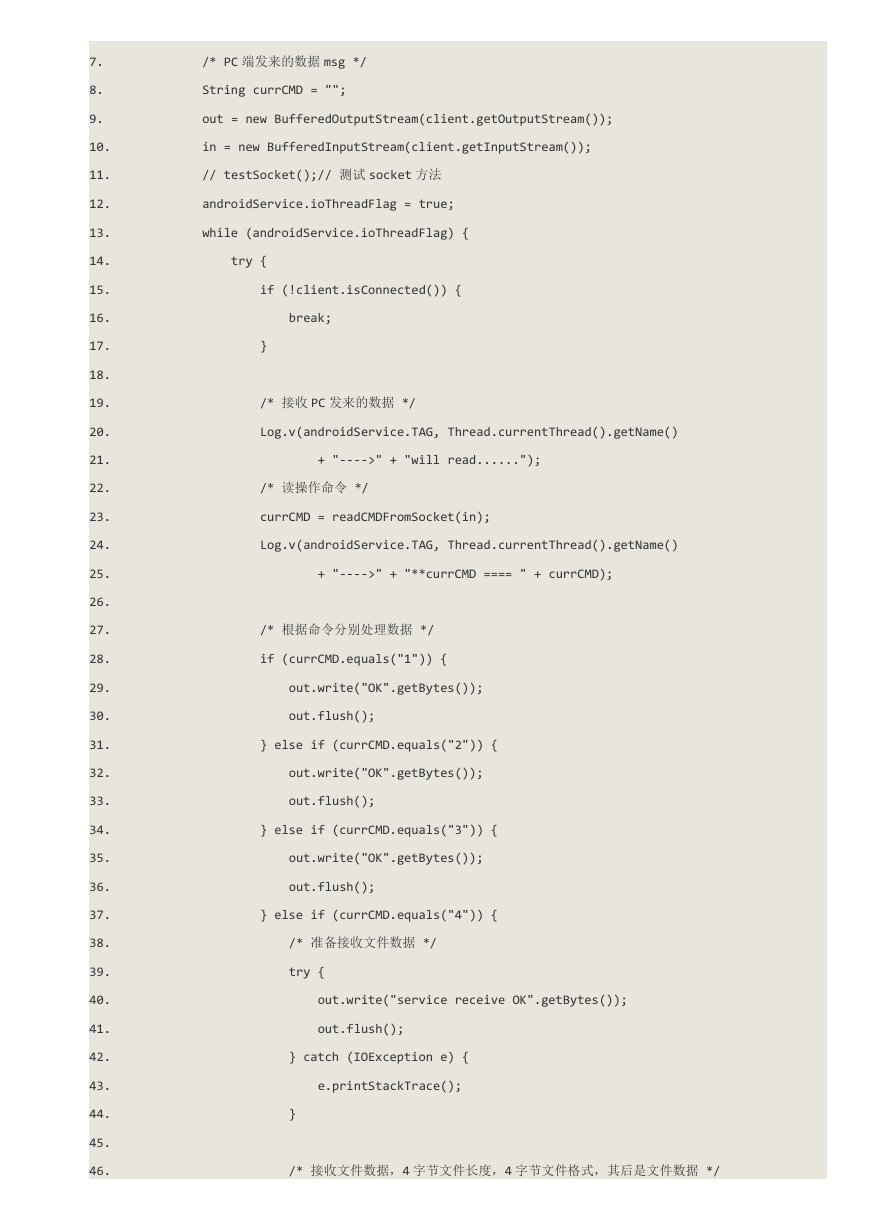
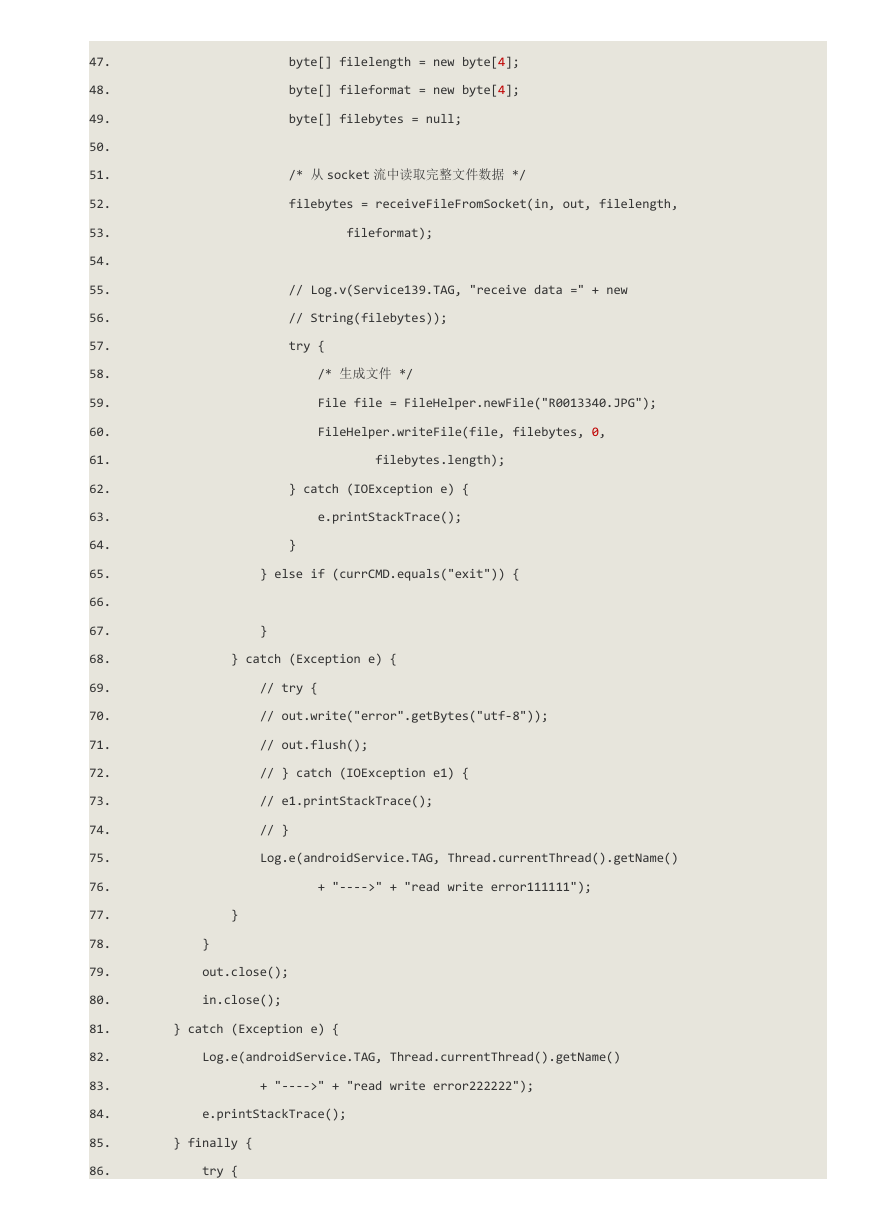
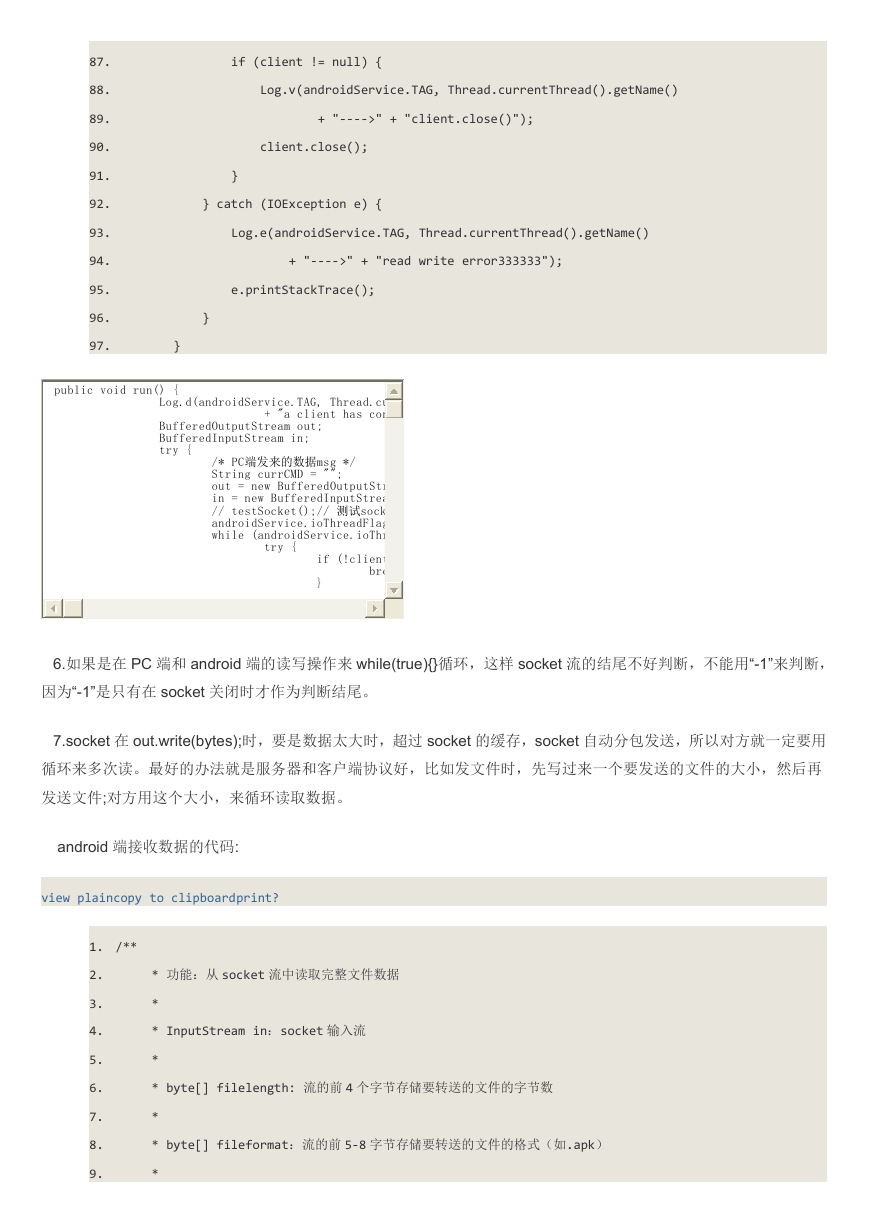










 2023年江西萍乡中考道德与法治真题及答案.doc
2023年江西萍乡中考道德与法治真题及答案.doc 2012年重庆南川中考生物真题及答案.doc
2012年重庆南川中考生物真题及答案.doc 2013年江西师范大学地理学综合及文艺理论基础考研真题.doc
2013年江西师范大学地理学综合及文艺理论基础考研真题.doc 2020年四川甘孜小升初语文真题及答案I卷.doc
2020年四川甘孜小升初语文真题及答案I卷.doc 2020年注册岩土工程师专业基础考试真题及答案.doc
2020年注册岩土工程师专业基础考试真题及答案.doc 2023-2024学年福建省厦门市九年级上学期数学月考试题及答案.doc
2023-2024学年福建省厦门市九年级上学期数学月考试题及答案.doc 2021-2022学年辽宁省沈阳市大东区九年级上学期语文期末试题及答案.doc
2021-2022学年辽宁省沈阳市大东区九年级上学期语文期末试题及答案.doc 2022-2023学年北京东城区初三第一学期物理期末试卷及答案.doc
2022-2023学年北京东城区初三第一学期物理期末试卷及答案.doc 2018上半年江西教师资格初中地理学科知识与教学能力真题及答案.doc
2018上半年江西教师资格初中地理学科知识与教学能力真题及答案.doc 2012年河北国家公务员申论考试真题及答案-省级.doc
2012年河北国家公务员申论考试真题及答案-省级.doc 2020-2021学年江苏省扬州市江都区邵樊片九年级上学期数学第一次质量检测试题及答案.doc
2020-2021学年江苏省扬州市江都区邵樊片九年级上学期数学第一次质量检测试题及答案.doc 2022下半年黑龙江教师资格证中学综合素质真题及答案.doc
2022下半年黑龙江教师资格证中学综合素质真题及答案.doc